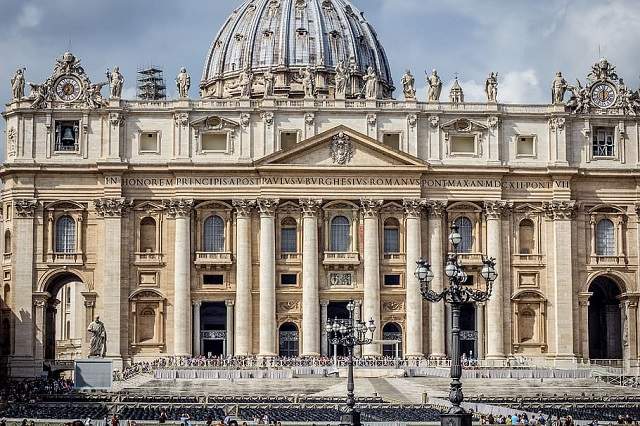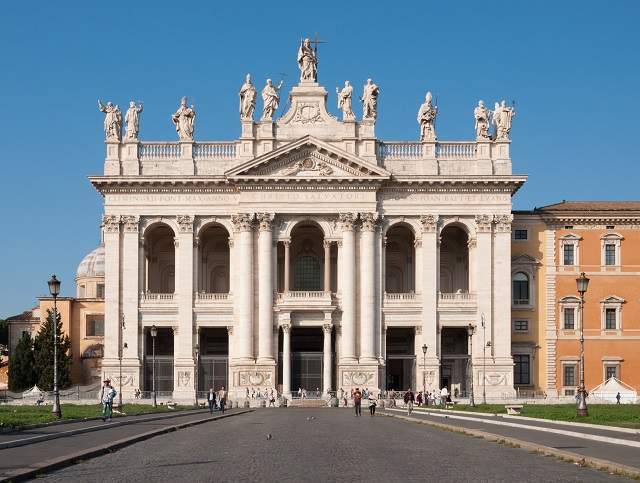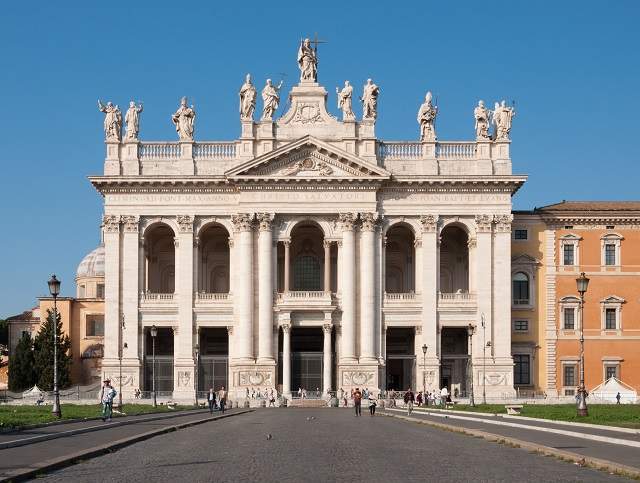Step into Rome, the Eternal City, a living museum cradled in the heart of Italy. As we embark on our journey, prepare to witness centuries worth of spiritual devotion mingled with artistic genius, masterfully brought to life within the walls of its numerous churches. Rome is not just a city; it’s a vibrant tapestry, each thread spun delicately from tales of faith and artistry, preserved impeccably over time.
From the domes that puncture the sky to the ancient cobblestone paths that whisper tales of bygone eras, each church in Rome is a pilgrimage in itself. They’re not merely buildings but timeworn pages of a layered narrative, chronicling Rome’s extensive past, rich culture, and deep spirituality. These structures, many centuries old, stand today as proud testament to Rome’s unbroken connection to its spiritual and artistic roots.
By delving into these architectural masterpieces, we are not merely touring a collection of old structures. Instead, we’re taxiing on the runway of an epic journey, with tickets to travel back through time, exploring the evolution of faith and art under the watchful eyes of cherubim and under the careful guidance of Italian masters.
Get ready to discover how each church, with its curiously intricate mosaics, breathtaking frescoes, and awe-inspiring edifices, acts as its own tour guide, leading the willing traveler deeper into the rabbit hole that is Rome’s fascinating history.
Whether you’re preparing your itinerary for an upcoming Roman holiday or an enthusiastic armchair traveler, passionate about uncovering lesser-known historical and cultural nuggets from the comfort of your home, you’re in for quite an adventure.
Let us traverse the hallowed halls of these magnificent structures together, shedding a fresh light on the timeless tapestry of faith and artistry that is entrenched in Rome’s churches. So, buckle your seatbelts, history, art and travel enthusiasts, as we set sail into the heart of Rome’s admirable past, one church at a time.
Historical Background of Rome’s Churches
Embarking on an exploration of Rome’s churches is like opening an illustrated history book that narrates the city’s rich, deep-rooted Christian heritage. Each church page tells its own fascinating story, reflecting Rome’s spiritual evolution and the layers of history that offer clues to the many architectural marvels we admire today.
Rome: A Melting Pot of Christianity
As the birthplace of Christianity in Western Europe, the Eternal City stands like a fortress with over 900 churches bearing witness to its unparalleled spiritual legacy. Rome has embraced different faiths since its inception, and as Christianity spread throughout the Roman Empire, these sacred sites began to burgeon. Let us venture into the journey of faith through Rome’s yesteryears and rediscover how divine intervention and historical events shaped the city’s religious landscape.
- The Early Christian Period (1st-4th centuries AD)
- Christianity’s foundation in Rome has its roots in the Apostles Peter and Paul, both of whom met their martyrdom in the city around 67 AD.
- The early Christian community, often persecuted, held clandestine gatherings in catacombs and house churches, leaving behind fascinating tales and architectural remnants that still captivate us today.
- The Edict of Milan (313 AD)
- Emperor Constantine’s historic proclamation of religious tolerance paved the way for Christianity’s rise from secrecy to a publicly accepted faith.
- This turning point allowed for the construction of grand basilicas, including the original St. Peter’s Basilica, on sites bearing sacred significance.
- The Middle Ages (5th-15th centuries)
- Rome’s churches flourished during this period, as Popes commissioned architectural masterpieces richly adorned with art and relics, reinforcing Rome’s spiritual grandiosity.
- Surrounded by splendid mosaics and intricate frescoes, we can still revel in the awe-inspiring ambiance of churches like Santa Maria in Trastevere, dating back as early as the 4th century.
- The Renaissance & Baroque Eras (15th-17th centuries)
- Esteemed artists like Michelangelo, Bernini, and Caravaggio left their indelible mark upon Rome’s churches, exemplifying the harmony between faith and artistic prowess.
- The city’s skyline transformed with lavish facades, opulent domes, and monumental altarpieces, embodying the seamless marriage of art and spiritual expression epitomized in churches like Saint Peter’s Basilica and Santa Maria del Popolo.
- Modern Times (18th century onwards)
- The evolution of Rome’s churches continued through the ages, featuring neo-classical and contemporary architectural styles that showcase the city’s ability to adapt and innovate.
- Some newer churches, like Richard Meier’s Jubilee Church, prove that Rome’s historic past and modern aspirations can proudly coexist, completing the city’s colorful religious tapestry.
Encompassing every twist and turn of Rome’s journey through time, its churches stand astride the millennia, housing precious memories in their halls. Whether adorned with deeply profound symbols or filled with captivating art, Rome’s churches continue to inspire us, drawing us ever closer to their ancient secrets and divine wisdom.
Tapestry of Faith: Iconic Churches in Rome
Rome, famously known as the “Eternal City,” serves as the veritable heart of Christendom. Sacred memories of the Saints linger around its every cobblestone corner and its skyline is adorned with a medley of captivating churches that bear testament to the city’s rich tapestry of faith. Among these hallowed sanctuaries, three churches stand remarkably taller: St. Peter’s Basilica, San Giovanni in Laterano, and Santa Maria Maggiore.
Rome enthusiasts, allow me to guide you through these timeless edifices that are not merely landmarks of stone and marble but rather portals into a vivid past adorned with faith, artistry, and history.
1. St. Peter’s Basilica
Crowning the charming Roman skyline, St. Peter’s Basilica, the largest church in the world, is a treasure trove of artistic masterpieces and a symbol of the Catholic world.
- History: Built on the grave of Saint Peter, one of Christ’s Disciples, the Basilica dates back to around 320 AD under Emperor Constantine’s rule. However, the magnificent structure we now see was constructed in the 16th century, transforming through the hands of renowned architects like Bramante and Michelangelo.
- Religious Significance: As the burial site of the eponymous saint, St. Peter’s Basilica holds a unique position in the Catholic world, embodying devotion that transcends time.
- Artistic Elements: Housing stunning pieces – from the captivating Pietà by Michelangelo to the astonishing St. Helena statue by Andrea Bolgi – St. Peter’s is a must-visit for every art lover.
2. San Giovanni in Laterano
Behind the Aurelian walls, San Giovanni in Laterano, the “Mother and Head” of all churches, rests in noble gravity, reflecting the sun’s radiant brilliance.
- History: Founded by Constantine in the 4th century, it’s been the Bishop of Rome’s – the Pope’s – cathedral for centuries. Despite its successive restorations, the cathedral remains imbued with a remarkably pristine charm.
- Religious Significance: With its rich history interweaving through Catholicism, San Giovanni in Laterano’s very walls breathe faith.
- Unique Aspects: Magnificent statues of the Apostles in the nave, stunning mosaics, and a larger-than-life statue of Constantine are just starters for a feast of artistry that the basilica lays out.
3. Santa Maria Maggiore
A symbol of heavenly tranquility, Santa Maria Maggiore, with its pristine façade and soaring bell tower, offers an immersive dive into centuries-long ecclesiastical history.
- Historical Importance: Founded in 432 AD by Pope Sixtus III, it is one of the only seven pilgrim basilicas in the world, with parts of the original structure still intact!
- Architectural Elements: The basilica showcases an enchanting blend of architectural styles – from its 5th-century foundations to 18th-century renovations. Don’t miss the glittering mosaics depicting Biblical scenes, spanning over centuries.
- Art pieces: Treasures like the ancient icon of the Virgin Mary, known as “Salus Populi Romani,” infuse the basilica with otherworldly beauty and mystique.
As our journey concludes, remember, dear travelers, that Rome’s churches aren’t just landmarks. They’re living portals to the past, offering glimpses of the eternal city’s celestial devotion painted across time. No trip to Rome is complete without stepping into these sanctuaries of faith, surrounded by their beauty and enveloped by their sense of tranquility. Each visit becomes a voyage towards understanding Rome’s spiritual, historical, and artistic significance – a delightful exploration into the heart of the Eternal City.
Artistry Behind the Altars: An Overview of Art in Roman Churches
Art is a vibrant language that transcends spoken and written words. In Rome, the story of faith, devotion, and history unfolds in bright colors and grand structures in the many churches dotting the city. Let’s dive in to unravel the fascinating artistry behind the majestic altars.
Frescoes in Roman Churches
Art reached one of its expressive peaks in the form of frescoes skillfully painted on the walls of Roman churches.
- What Is It: Frescoes involve applying paint onto wet plaster, creating vibrant, long-lasting artwork.
- Historical Epoch: Primarily found in churches dating back to the Middle Ages and Renaissance.
- Example: The frescoes in the Basilica of San Clemente, depicting stories from the Old Testament, are breathtakingly beautiful and rich in detail.
Mosaic Work in Roman Churches
Mosaic art adorning Roman churches reflects the city’s rich artistic heritage from the Byzantine era.
- What Is It: Mosaics involve creating images or patterns by assembling small pieces of stone, glass, or other materials.
- Historical Epoch: Prominent in churches built during the Byzantine period.
- Example: The stunning mosaic of Christ in Majesty in the Basilica of Santa Prassede is a resplendent remnant of Byzantine artistry.
Sculpture in Roman Churches
Sculpture in Roman churches adds a tangible dimension to their artistic charm.
- What Is It: Sculptures are three-dimensional representations meticulously crafted from materials like stone, wood, or bronze.
- Historical Epoch: Prolific during the Renaissance and Baroque periods.
- Example: Michelangelo’s Pietà in St. Peter’s Basilica is a stunning masterpiece that showcases sculptural magnificence.
Architectural Splendor
The architecture of Roman churches stands as a testament to centuries of evolution in design and style.
- What Is It: Architectural styles span from simple early Christian designs to ornate Baroque constructions.
- Historical Epoch: Rome’s churches echo the architectural trends across all epochs, including Roman, Medieval, Renaissance, and Baroque.
- Example: The rounded arches of Santa Maria in Trastevere showcase Romanesque architecture, whereas the dramatic opulence of Sant’Agnese in Agone epitomizes the Baroque era.
In summary, the artistry behind Roman churches’ altars offers a vibrant journey through time. Whether in the form of expressive frescoes, intricate mosaics, lifelike sculptures, or evolving architecture, every piece adds a unique verse to Rome’s everlasting symphony of faith. Remember, when you visit, you don’t simply witness buildings and art; you step into visual chronicles that have shaped the Eternal City’s spiritual and cultural landscape.
Serving the Community: Churches’ Role in Rome Beyond Religion
The Eternal City, Rome, tantalizes not just with its timeless artifacts and delectable cuisine, but also with an often overlooked yet vital aspect – its churches functioning as community hubs. In Rome, churches aren’t just epicenters of religious fervor; they’re bridges that connect the past with the present, and the sacred with the societal. Let’s explore their multifaceted roles intertwining with Rome’s everyday life.
1. Community Spaces
Far beyond their sacrosanct aura, Roman churches often transform into vibrant local meeting points.
- Connecting the Community: Churches like San Luigi dei Francesi or Sant’Agnese in Agone commonly host gatherings, fostering a sense of community and facilitating social interactions.
- Events and Celebrations: From quaint local festivals or ‘sagras’ to grand weddings, churches offer the perfect magical backdrop for various events. Imagine basking under the historical aura of St. Peter’s during the vibrant Easter festivities!
2. Centers for Art and Education
In Rome, churches seamlessly amalgamate religion with education, and enlightenment isn’t purely spiritual!
- Art Education: With their vast collection of artwork, churches serve as “open art galleries.” The frescoes, sculptures, and mosaics within churches like Santa Maria del Popolo offer a unique, vivid art lesson.
- Historical Lessons: Churches like the Basilica of San Clemente offer didactic insights into different historical epochs, with its layers virtually presenting a timeline dating back to the Roman Empire.
3. Cultural Preservation
Churches are the beating heart of Rome, pumping life into the ancient city’s rich history, and nurturing its vibrant culture.
- Upkeeping Tradition: Churches play a crucial role in preserving Roman heritage, be it showcasing ancient liturgical practices or hosting traditional music concerts.
- Cultural Events: Often, churches host events highlighting Rome’s rich culture, such as the live nativity scene during Christmas at the Church of Saints Cosmas and Damian.
From functioning as communal spaces, acting as educational centers, to preserving cultural heritage, the versatility of Rome’s churches burgeons beyond their spiritual confines. As they extend their embrace to hold the threads of Rome’s social fabric closely knitted, the churches transform into living spaces, pulsating along with Rome’s beating heart. So, remember, on your next Roman holiday, to look beyond the spiritual significance of these churches and delve into the more worldly roles they play, becoming an integral part of Rome’s charm and vitality.
Practical Information for Visitors: Exploring Rome’s Churches
Rome: a city where every cobblestone whispers tales from the past, and every day is a journey through history. Amidst gladiatorial arenas and imperial parks, Rome’s churches stand as sanctuaries of serenity, radiating eternal beauty. With each visit, you step into a legendary saga, a mesmerizing encounter with art, culture, and spirituality. Ready for your Roman Church adventure? Let’s guide you with some practical info!
Visiting Hours
Rome’s churches welcome everyone with open arms. However, to respect the sanctity of services:
- Standard Timings: Most churches open by 7 am and close around 7 pm.
- Service Time: There might be limited access during Mass.
- Changing Schedules: Some churches may alter the timing based on the season. It’s wise to check their official websites beforehand.
Dress Code and Etiquette
Walking in Rome’s sacred spaces, you’re not merely a visitor; you’re a respectful participant in their customs.
- Appropriate Attire: Churches require modest clothing. Cover your knees and shoulders.
- Silence: Maintain a peaceful environment and respect ongoing religious activities.
- Photography: Flash photography is often frowned upon. Check for permission signs.
Entry Fee and Guided Tours
An enriching exploration of Rome’s churches is mostly compliments of the city!
- Free Entry: Most churches do not charge an entrance fee.
- Guided Tours: Some churches offer paid guided tours for a more detailed insight. For example, St. Peter’s Basilica provides guided tours starting from €27.
To wander through Roman churches is to wander through the labyrinth of time itself, to marvel at the ingenuity of past artisans and feel the pulsating heart of the Eternal City. So, grab that map, pack your explorer spirit, and step forth! Promise yourself an insightful journey through Rome’s churches, where every turn unravels a new story, a new wonder waiting to be discovered. After all, as someone wise once said: “All roads lead to Rome!”
Remember, the key to a fulfilling Roman church experience lies in understanding their heritage and respecting their customs. So, dress modestly, speak softly, admire quietly, check the timing, and freely surrender yourself to the allure of Rome’s ethereal ecclesiastical charm. Happy exploring!
Rome’s Churches: Rediscovering the Heartbeat of the Eternal City
As we conclude our journey into the mesmerizing realm of Rome’s churches, we stand in awe of their grandiosity and charm. We have roamed through artistic masterpieces gracing their walls, marveled at the whispers of history wafting through their hallowed corridors, and witnessed the profound impact these sacred spaces have on the very essence of Rome. Our exploration, like a beautifully woven tapestry, paints a vivid picture of the undeniable allure that envelops Rome’s churches, beckoning us to step into their enchanting embrace, time after time.
We traveled through time, observing frescoes unfold divine stories on silent walls, mosaics glitter from bygone eras, and sculptures capture human emotions in the unforgiving bronze or marble. Each church, a treasure trove of artistry unmatched, inviting us to admire, learn, and forever cherish.
We delved deeper to understand the intertwining roles of churches, both spiritual and secular: spaces for the community to gather, celebrate, and engage; centers for enlightening minds with rich histories, invaluable lessons, and artistic marvels; and preservers of Rome’s ancient customs and vibrant culture that continue to thrive.
And finally, equipped with the practical know-how to enjoy these wonders, we set out to chase Rome’s heartbeat, listening as it calls to us, guiding us through a pilgrimage of soulful experiences, historical explorations, and cultural encounters.
As our in-depth expedition into Rome’s ecclesiastical universe comes to a close, we are left with a profound understanding of the unbreakable bond between the Eternal City and its sacred spaces. Perhaps, your thirst for knowledge has been ignited, or perhaps the exhilarating tales of these churches tempt you to plan your next adventure. Regardless, we hope your quest to discover Rome’s churches knows no end, and as you walk along the streets of Rome, remember to peer through the open doors to glimpse the stories that lie within, waiting to be rediscovered, time and again. So, dear traveler, are you ready to embark on a truly unforgettable journey through the heart of Rome’s churches?








